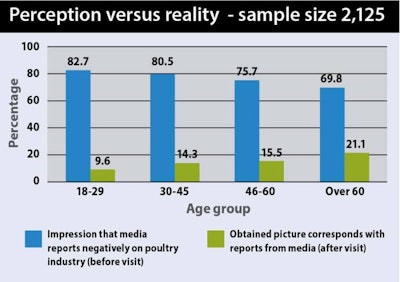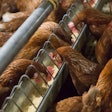
Research in the fields of communications and public relations has shown that the meat industry, including the poultry sector, has a distinct image problem, due to a longstanding lack of transparency across the whole value chain.
Concurrently, there is the ever-present debate around sustainable development. Stakeholders in the sustainability debate, and the public at large, increasingly demand information about food safety, animal welfare and environmental protection. Additionally, recent scandals surrounding the meat industry have further damaged public confidence in the ability of meat producers to ensure safety.
The lack of transparency in the meat sector has encouraged the media and the public to fill this communication void with information from elsewhere – be it objectively accurate or not. In Germany, this has led to wrong assumptions, the disparagement of modern-day farming and farmers, and emotionalized discourse.
In 2012, a unique project, Transparency in Poultry Production, was launched by the Science and Information Centre for Sustainable Poultry Production (WING), at the University of Vechta, Germany.
The project seeks to address the poultry industry’s urgent need to be more transparent. Additionally, it aims to contribute to a professional and rationalized discourse on sustainable poultry farming. The project is supported by the Lower Saxony Poultry Association (NGW).
Between 2012 and 2014, 7,000 visitors came to 30 farm openings, of which 28 were in Lower Saxony, where the German poultry industry is concentrated, and two in North-Rhine-Westphalia. Egg, broiler, turkey and goose producers opened their doors to the public.
Talking to the consumer
Key to the project is a scientific survey which is conducted on every farm that holds open days.
The survey’s aim is to compare visitors’ assumptions and perceptions of the poultry industry before visiting the poultry houses, and their impressions once the farms have been visited. Visitors are questioned on arrival and after leaving the poultry houses. Information professionals are on hand should visitors have any questions.
Of the 7,000 visitors, 3,160 were approached for the survey. Any farmers or agricultural employees that may have visited were excluded from the analysis to ensure that results were obtained from the desired target group, i.e. consumers who had never seen the inside of a poultry house. Visitors under age 18 were also excluded from the analysis, as they were not deemed to be active consumers, and so the results were based on 2,125 interviews.
Second-hand knowledge vs. first-hand impressions
Before visitors entered the poultry houses, they were asked to assess if media reports are prejudiced against poultry farming. For the analysis, four age groups were defined to discover if there are differences in opinion depending on age (Graphic 1).
Those ages 18-29 agreed most strongly with the statement that media reports are negatively biased. Conversely, the oldest age group believed the least that the image produced by the media is negatively biased (69.8 percent).
However, at between 70 and 83 percent of respondents per age group, the overall impression among respondents was that the media is negatively prejudiced against the poultry industry.
Innocence and experience
Once the interviewees had left the poultry house, they were asked if their informed impression of poultry farming corresponded with what had been learned from the media. Overall, the new impressions deviated strongly from the negatively tinted image the participants had received from the media.
Looking at the differences between age groups, the findings indicate that the oldest age group disagreed most strongly with media reports that are slanted against poultry husbandry. Additionally, they related the source of their preconceived ideas more to the media than was the case for the younger generations.
This could either mean that they are uncritical of the media, or that they acknowledge the veracity and correct portrayal of the poultry industry by the media. The latter could be traced back to their experience of smallholder farming in the first half of the 20th century.
Mechanization, increasing industrialization, and the green revolution have transformed smallholder to industrialized farming over the past 50 years, and there could be a disconnect between modern poultry production and those over age 60.
The youngest age group was found to be generally more critical of media reports. They hardly associated their first-hand impressions of poultry production with the negative image they had gained from the media. Growing up during the rise of the information age could be an explanation for their critical attitudes toward the media. As active participants on digital media platforms, they could be more aware of misconceptions.
A high proportion of the middle age group (30-45) is as critical of media reports as the youngest generation. However, contrary to the younger, the middle age group attributed their negative images of the poultry industry more strongly to the media.
An explanation for this could be the generational predisposition to be a parent. This could suggest enhanced care and responsibility for future generations, resulting in reservations about food-producing systems.
Attitude change post house visit
Additionally, participants’ attitudes to their visit were sought, and they were subsequently asked to give their first impression when exiting the poultry house. They were also asked to give their opinions on the German poultry industry in general in light of their visit.
In total, 18 percent of the 2,125 visitors were skeptical at the start of the farm visit. However, on leaving the poultry house, this figure had fallen to 7.4 percent with the overall negative impression of German poultry production being 5.6 percent of all interviewees.
The youngest group was least skeptical before entering the poultry house (15.2 percent), and as age increased skepticism rose. This trend was partly reversed as visitors left the poultry house.
While the oldest age group was most skeptical prior to entering the poultry house, opening up the farm for them to see resulted in this age group leaving with the lowest levels of skepticism.
Although the educational event was also able to address skepticism in younger generations, the proportion of negative impressions remained higher.
One of the last questions in the questionnaire sought to reveal visitors’ general perspective on the poultry industry.
Overall, the proportion of negative impressions of the poultry industry was low. About 5 percent of the two highest age groups (46-60 and over 60) ended the farm visit with negative impression. A slightly higher number of the two younger age groups, 18-29 and 30-45, went home with a negative impression, 6.6 percent and 6.4 percent, respectively.
Commitment for success
The transparency project not only enabled the project group to gather information on consumer assumptions and expectations, but opening up the farm – being transparent – effectively overturned the fears and prejudices of visitors.
The project organizers believe that the initiative has contributed to objectively changing incorrect assumptions about poultry production across generations, each with its own unique mindsets, values and scopes of tolerance.
Transparency has served as a win-win situation for producer and consumer alike. The producer can move from “reacting,” or defending against poor reporting, to a proactive approach by inviting the public, media and critics to engage in dialogue.
For transparency to be sustained, however, it is essential that producers remain accessible to the public, to build and maintain confidence and credibility in their work.


















